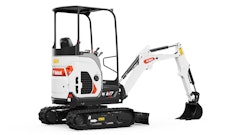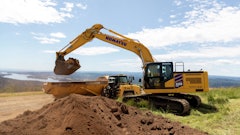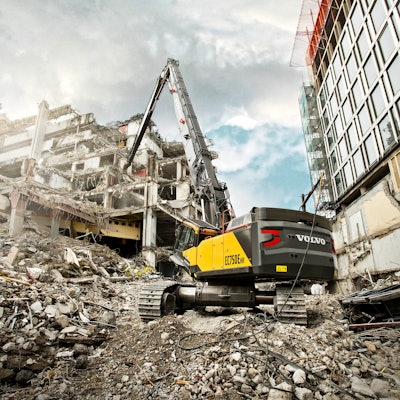
Most excavator manufacturers offer a choice of boom and arm configurations to tailor excavators for specific applications. Most often these include a short, standard and long arm. Each of these has its respective benefits and drawbacks.
Consider the shorter or mass excavation arms. “That shorter boom and arm allows additional lift capacity because you are working closer to the machine and allowing quicker loading of the truck,” says Aaron Kleingartner, marketing manager, Doosan Infracore North America, LLC. The longer arm is for contractors who need a little extra reach vs. the standard arm for dig depth or truck loading.
Read next: Long-reach Excavator Setup Tips
In addition to standard configurations, many manufacturers offer dedicated super long-reach packages that can reach 60-plus ft. and dedicated high-reach excavators that can extend up to 160 ft. Super long-reach excavators are intended to reach horizontally while high-reach excavators extend vertically.
Whenever you put longer booms or arms on a machine, there are trade-offs to consider. “The biggest is machine balance,” says Kleingartner. The center of gravity is moved further from the center of the machine. “By physics, that means you have a lower lift capacity the further that you go out from the machine.”
The same principal applies to attachments. “The longer the front, typically the smaller the attachment allowed,” says Andrew Earing, product manager, Komatsu. “Over the side stability becomes a trade-off that customers have to analyze and understand. Then there is the overall weight as it pertains to the transportability.”
When it comes to the carrier, a long boom and arm doesn’t necessarily translate to greater forces on the machine itself. Despite the extended reach, long-reach and high-reach booms and arms typically exert similar forces on the excavator body as standard booms and arms. “As you extend reach, your bucket sizes go down,” says Kurt Moncini, senior product manager, Komatsu. “You are trading reach for capacity. The actual load on the machine stays about the same.”
Reach for the Sky
The high-reach excavator allows precise, “surgical” demolition of tall structures. On some of the newer high-reach excavators, the cabs tilt backward at an angle so the operator can work without having to strain his/her neck trying to look upwards. Some of the higher reach excavators are equipped with a camera at the arm tip to provide close-up visibility of the work through an in-cab display screen. Some models also have a water line with a mist sprayer at the end to minimize dust emissions when used with shears and concrete pulverizers to comply with EPA dust emissions regulations.
Discover more: [VIDEO] Contractor Uses High Reach Excavator for Complicated Bridge Demolition
 The high-reach excavator allows precise, ‘surgical’ demolition of tall structures. On some of the newer high-reach excavators, the cabs tilt backward at an angle so the operator can work without having to strain his/her neck trying to look upwards. Image source: Caterpillar
The high-reach excavator allows precise, ‘surgical’ demolition of tall structures. On some of the newer high-reach excavators, the cabs tilt backward at an angle so the operator can work without having to strain his/her neck trying to look upwards. Image source: Caterpillar
Dedicated high-reach excavators have built-in performance-enhancing features. “No. 1 is going to be a wide undercarriage — what we call a square footprint,” says Earing. This maximizes machine stability. Next is the tilting cab. “When you are up 50 to 70 ft. or more, you really need to bring that cab back and allow that operator a comfortable position.” Third is quick-attach booms or quick-attach work equipment that simplifies breaking down the machine for transport. “The fourth would be additional hydraulic circuits. When working with attachments that rotate and/or three-piece high-reach booms, up to three or four additional hydraulic circuits and a case drain may be required.”
Safety features on a dedicated high-reach machine set it apart from a long front machine. “Our high-reach machine has built-in safety features and alarms that warn operators if they are working the machine unsafely,” says Marcus Barnes, product specialist, Liebherr USA, Co. “The high-reach attachment’s movements are shown on a separate screen, so the operator knows its position at all times. Sensors on the high-reach attachment also monitor machine movements.”
These safety features are not on a long-reach attachment. “Also, high-reach machines have bigger hoist cylinders on the working attachments, enabling them to pick the high-reach attachment off the ground and hold a heavy tool in the air,” Barnes points out.
The trick with high-reach excavators is to choose a boom configuration that will achieve your most demanding jobs, yet offers versatility. Consider a high-rise building. “The structure may have lighter steel at the top, so you would prioritize maximum pin height over tool weight,” says Reeves. “The strongest material is often at the bottom of the structure. So in that situation, you wouldn’t need as much height, but you would need a boom configuration that can support a heavier tool.” For example, the Volvo EC750E HR has two high-reach demolition boom sets and one digging boom set with an extension.
Volvo’s dedicated high-reach machines are based on existing models with some added features to make them suitable for high-reach demolition. “For instance, the EC750E HR high-reach excavator is based on our popular EC750E crawler excavator, but has been re-engineered for high-reach deconstruction purposes with a heavier and wider undercarriage and factory-fitted guarding. Other features you see on dedicated Volvo high-reach machines that differ from standard excavators include larger boom cylinders, extra counterweight, hydraulically extendable tracks, tilting cabs and dust suppression systems,” says Reeves.
High-reach Requires Skilled Operators
Make sure you only allow the most competent operators to run high-reach excavators.
“High reaches are more susceptible to tipping over for a non-experienced operator. With these machines, you are handling heavy tools from 70 to 130 ft. in the air trying to take down a structure,” says Barnes. “You have to have an experienced operator who understands the science behind how to deconstruct a structure and how to do it safely so that the structure won’t fall on them. High reach machines have bigger hoist cylinders on the working attachments, enabling them to pick up the high-reach attachment off the ground and hold a heavy tool in the air. Image source: Liebherr
High reach machines have bigger hoist cylinders on the working attachments, enabling them to pick up the high-reach attachment off the ground and hold a heavy tool in the air. Image source: Liebherr
“Most dedicated high-reach machines come with some kind of safety system to help prevent the operator from tipping over a machine,” he adds. “You don’t see those kind of systems on a long front.”
Reeves recommends using an operator who is trained and experienced in working overhead. “Regular excavator operators are used to looking down into a hole, whereas high-reach operators are looking into the sky. This is a big adjustment — with clouds blowing by, they may have to overcome vertigo,” he explains. “For this reason, some of the best high-reach operators were previous crane operators. It also takes practice to work with the different types and sizes of demolition attachments that a typical excavator operator doesn’t generally have experience with. Volvo offers specialty training simulators to teach high-reach operation, and we definitely recommend that type of experience.”
There is more to running a high-reach demolition machine than simply being proficient at machine operation. “When you are doing demolition, it is very important for an operator to know and understand how that building is potentially going to come down,” says Earing. “They have to understand the physics.”
Work at a Distance
“Long-reach excavators are about maximizing the working range to do the work in the most safe and efficient manner,” says Brian Stellbrink, product application specialist, Caterpillar. “There are certainly trade-offs and limitations associated with extending the working range of a hydraulic excavator. Perhaps the most significant consideration is the bucket capacity and resulting production level one can expect. For example, with our mid-size super long-reach excavators, we are talking about nearly doubling the maximum reach to 60 ft. as compared to conventional fronts. This will obviously reduce the bucket capacity in order to maintain stability and structural durability when working at those long distances.
 Whenever you put longer booms or arms on a machine, there are tradeoffs to consider. The biggest is machine balance. The center of gravity is moved further from the center of the machine. Image source: Doosan
Whenever you put longer booms or arms on a machine, there are tradeoffs to consider. The biggest is machine balance. The center of gravity is moved further from the center of the machine. Image source: Doosan
Machine stability is a major consideration with long front machines. “Due to machine stability, super long front will limit size and weight of the attachment,’ says Sung Sook Kim, product manager, excavators, Volvo CE. “For example, a 22-ton size long front can use a 14-ton class bucket or attachment.”
The performance trade-offs limit super long front packages to niche applications. “You usually see medium-sized arm and boom combinations in most contractor fleets of equipment because the work for long front excavators can be few and far between if it’s not part of their primary business,” notes Barnes.
Unlike high-reach excavators, super long front machines don’t require specialized operator skills. “Similar to a more conventional excavator, super long-reach excavators are relatively simple and easy to operate,” says Stellbrink. “We develop these machines to be an extension of the more conventional machine, resulting in a similar operator interface and feel. A key difference is obviously the proximity to the work tool and the range the fronts move through as the machine works. This is different and takes some getting used to for the operator.”
“[With] a super long reach, for the most part you are still digging and still using that same type of motion with your hands to operate,” says Kleingartner. “There are no special skills other than you have to be much more aware of a larger area of influence just because you have a greater reach with the machine.”
Conversions Become a Balancing Act
Contractors usually have varying needs on the jobsite. “This may result in the desire to use a super long-reach configured machine in a more conventional digging application that does not require the extended digging range,” says Stellbrink. “This is typically not optimum in terms of performance and efficiency. While this can be done for shorter durations, the contractor should really consider either a second conventional standard-reach excavator or switching out the entire front parts.”
Caterpillar offers a number of purpose-built super long-reach excavators from 55,000 to 215,000 lbs. with reach from 47 to 77 ft. These purpose-built machines incorporate a heavier counterweight and special boom, stick and bucket linkage. The hydraulic system is also modified to optimize performance of the longer fronts.
“While the Caterpillar Super Long Reach excavators are purpose built, they do share significant commonality with the more conventional-reach excavator,” says Stellbrink. “We do currently have contractors with two sets of fronts for a single machine. In these cases, changing the fronts typically happens after many months, different projects or after large phases rather than shorter durations.”
 Machine stability is a major consideration with long front machines and the longer reach will limit bucket and attachment size. Image source: Volvo CE
Machine stability is a major consideration with long front machines and the longer reach will limit bucket and attachment size. Image source: Volvo CE
Turning a standard excavator into a super long reach machine can be even trickier. “If you are converting one of your existing excavators, you do need to take into account the amount of additional counterweight you will need to offset the longer attachment,” says Barnes. “You will also need to see if you will need bigger hoist cylinders to be able to lift the longer attachment.
“When you start getting into attachments with about 65 ft. of reach or more, you may also want to verify your current undercarriage will be able to handle that amount of reach,” he adds. “A wider undercarriage will give more lift capacity over the side and make the machine feel more stable.”
Komatsu offers super long front packages for its 210 through 490 models. “We have put heavier counterweight on it, reinforced the frames,” says Moncini. If choosing to add a super long front to a standard machine, you need to make sure it is up to the task. “Make sure the manufacturer has taken the time and attention to detail on basically coming up with a package designed for Super Long Fronts rather than simply taking a standard machine and putting the long front on it.”
Converting high-reach excavators to/from a standard configuration is also possible. Volvo offers a unique modular boom concept with its high-reach excavators. “Our high-reach excavator is a modular boom concept. Because of the convertible boom, a standard excavator can become a high reach pretty quickly,” says Reeves.
Doosan does not offer a dedicated high-reach machine. “We can provide a machine to a user without the boom and the arm on the front of it, which comes as just a base machine and then they can install a third-party high-reach boom,” says Kleingartner. However, the company does offers a factory Super Long Reach package on three of its models. “Those are only available on select Doosan machines. If [the customer has] a need for a boom/arm configuration that we don’t offer, they can order a machine without the boom and arm from us directly and go to a third-party provider that produces specialty applications and can configure a machine. We work with those suppliers to make sure that the customer gets what they need.”
Rental also needs to be carefully considered for occasional use applications. “Most of our dealers have these Super Long Front machines in their dealer fleet because it is so much more efficient for a contractor to rent a machine for a month or two months,” says Moncini.  Two-piece booms offer an advantage when you need to work close in to the machine. Image source: Volvo CE
Two-piece booms offer an advantage when you need to work close in to the machine. Image source: Volvo CE




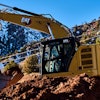
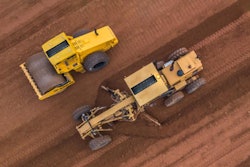
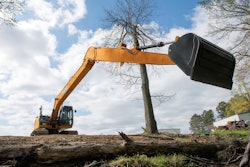
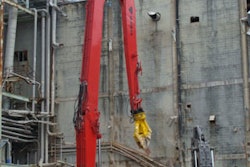







![Hcm Ax Landcros Dual Branded Logo[25]](https://img.forconstructionpros.com/mindful/acbm/workspaces/default/uploads/2025/11/hcmaxlandcros-dual-branded-logo25.Qhg3vUCjoK.jpg?ar=16%3A9&auto=format%2Ccompress&bg=fff&fill-color=fff&fit=fill&h=135&q=70&w=240)
